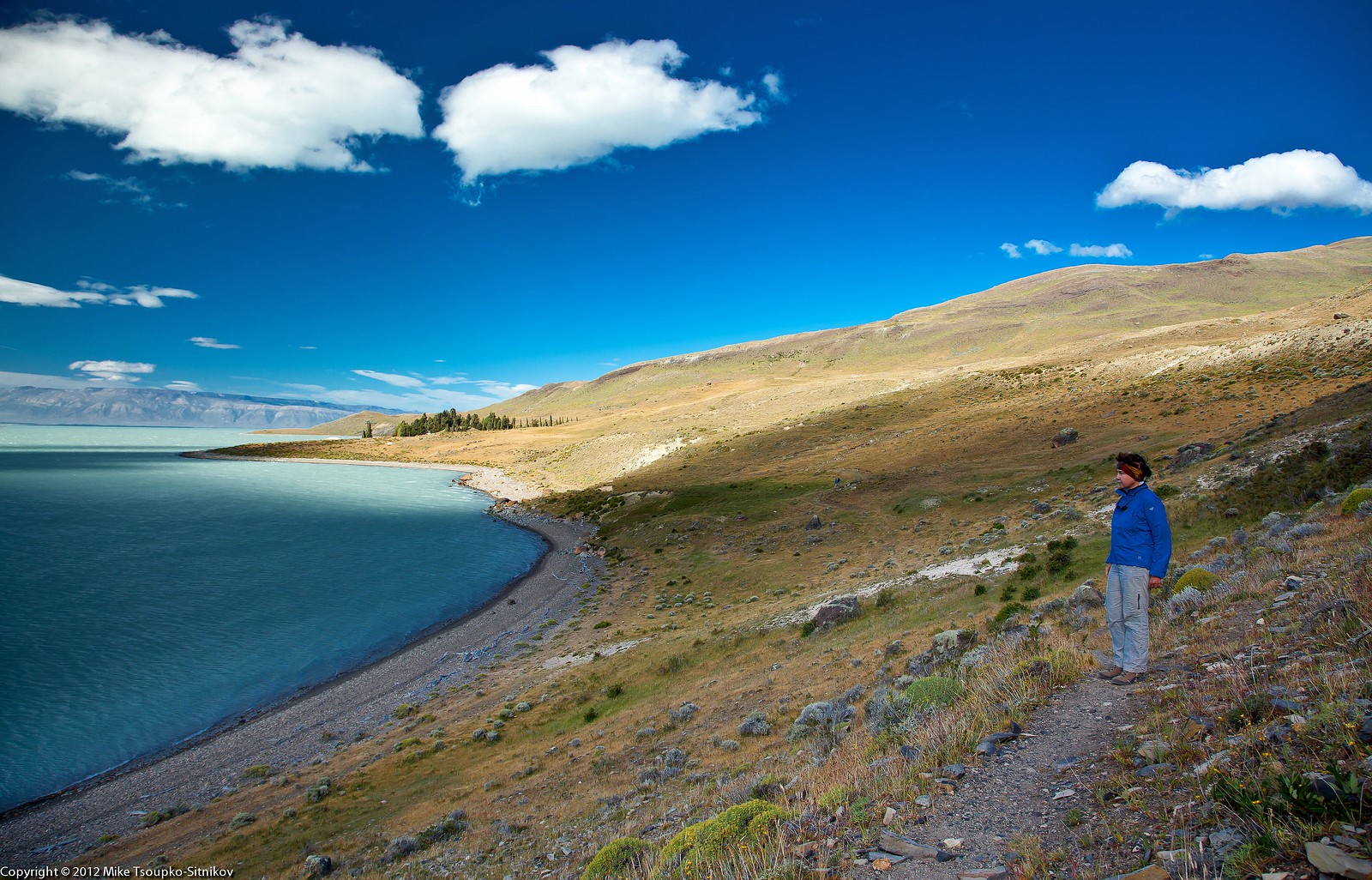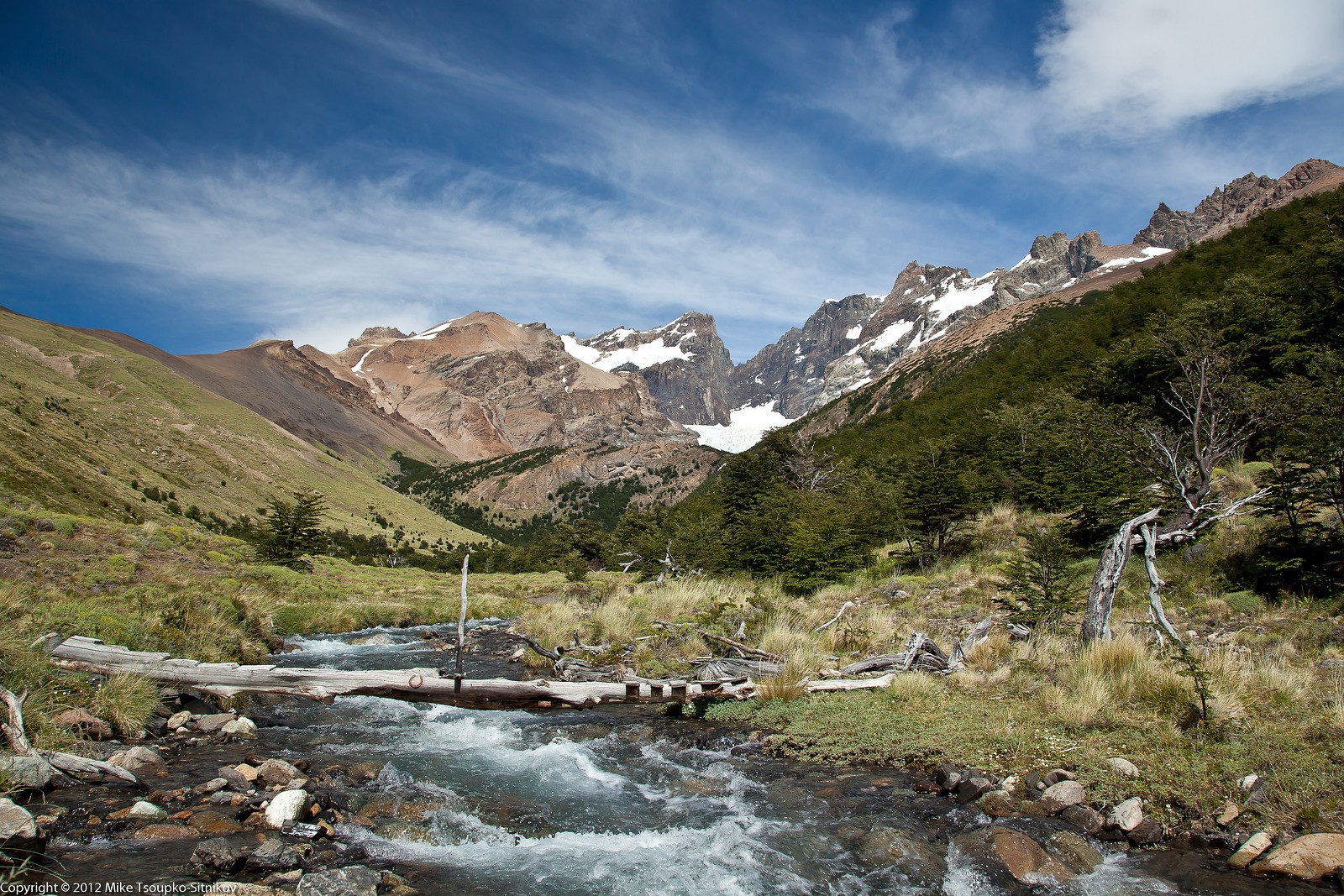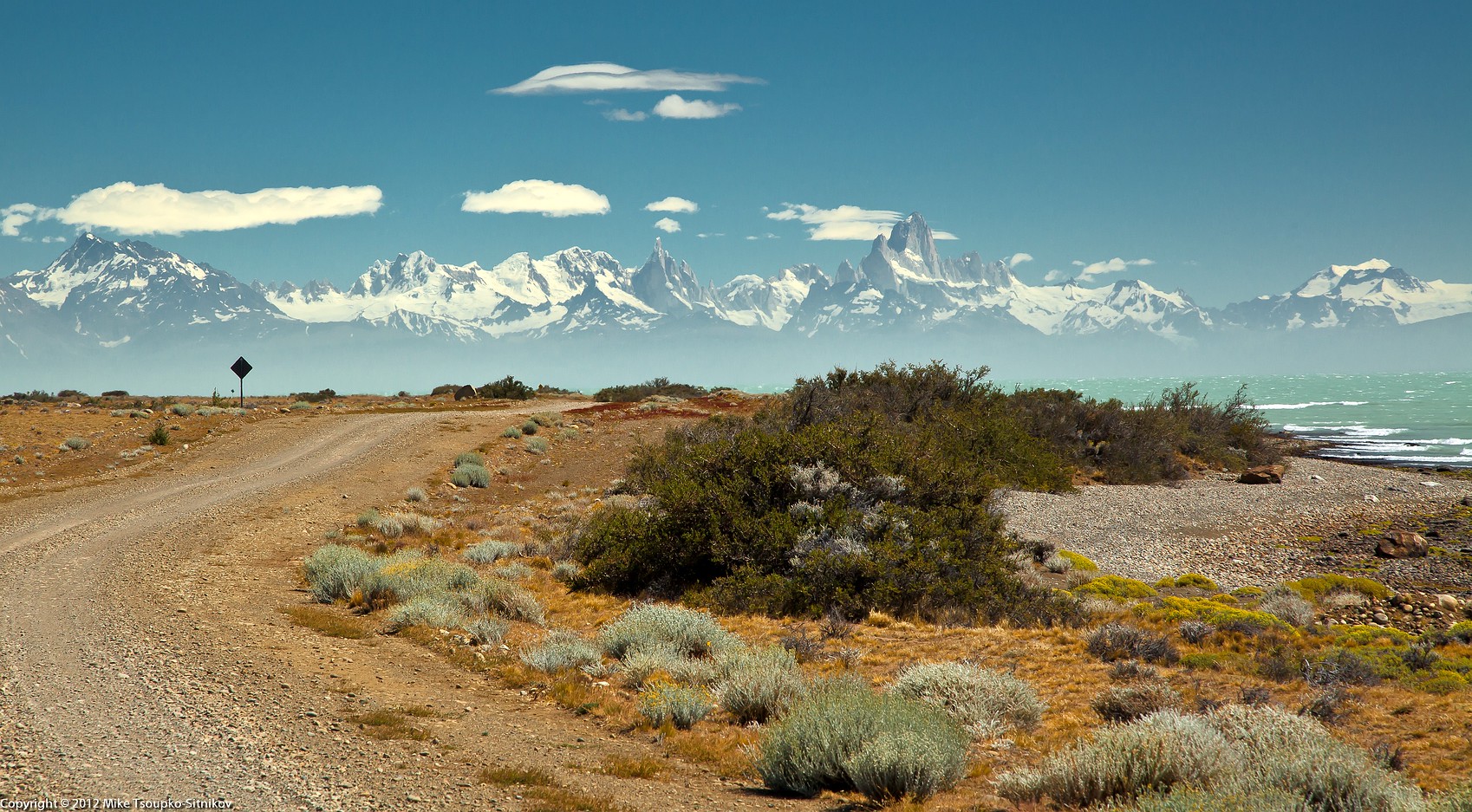Estancia Helsingfors is located in one of the most charming and strikingly gorgeous settings that I’ve ever seen. Some compare it to the magic world of the Lord of the Rings.
The Estancia, also called Lodge Helsingfors, is situated at the southwest corner of Lake Viedma in Los Glaciares National Park of Argentina. The lodge has 9 rooms, a common area with a fireplace, and a dining room. The food is excellent.
The place was founded as a ranch by emigrants from Finland which was then part of the Russian Empire. They called the place Helsingfors after the capital of Finland as it was officially known at the time (it now goes by Helsinki).
As you approach Estancia Heslsingfors, once you pass La Leona station the road becomes unpaved and follows the south shore of Lake Viedma, heading to the west. An imposing skyline appears at the horizon ahead, formed by jagged ridges of the Andes and the snows of South Patagonia Ice Field:
• The border between Argentina and Chile goes through this ice field. Some of the rocks you see are on the Chilean side and some on Argentinian.
The Lodge itself is hidden in a grove of conifer trees (bottom center in the picture below) that partially shield it from the strong western winds that blow relentlessly from the Andes.

• The place is quite self-sufficient. No cables or pipes connect it to the outer world. The phone, internet and television come from the satellite dish. Food and gas for cooking/ heating are delivered by truck. The electricity comes from a small turbine powered by a nearby stream, which is also the source of fresh water.

• All of Patagonia is windy but in this particular place the western winds that come from the Andes are funneled through a glacier-carved gorge in South Patagonia Ice Field. Many of the trees around this area have thus obtained an asymmetric shape with all branches pointing down the wind.

• The lodge is hidden in this tree grove. It is rather nondescript on the outside, but warm and cozy on the inside. The service and food are great, and the rooms are clean and comfortable but not luxurious. You won’t want to spend a lot of time in the room anyway.

• If you arrive with a group there is a good chance that the staff will treat you to a welcoming meal at the picnic area outside, introducing you to the local cuisine and Argentinian wine:
• While chewing your roasted lamb, empanada or squash, don’t forget to look around because you won’t wind such settings in most of the best restaurants in the world:

• Lake Viedma is formed by the glacial water that contains a sediment that gives the it the color that varies from gray to blue to surreal turquoise depending on the light. The water comes mostly from the Viedma Glacier that flows into the lake.

Punta del Viento Hike
Punta del Viento, or the the Wind Peninsula, is located within an easy hour-long hike from the lodge. The trail heads west and follows the shore of Lake Viedma.

• Soon the trail leaves the territory of the former Helsingfors Ranch, and continues along the shore of a fjord.

• Let’s take a look back at the ever-changing view of Lake Viedma with the shadows of the clouds moving across its turquoise surface:

• We keep heading forward and the mountains get closer:

• A few more minutes and we reach the Wind Peninsula. It deserves its name. It is literally hard to keep your balance – so strong is the wind. A hat, scarf or glove that are let loose would disappear in a split second without hitting the ground. We had fun leaning into the wind and letting it support the weights of our bodies:

• Sometimes the wind gusts won’t let me keep the camera stable, resulting in blurry shots:

• We turn back and find a spot that is shielded from the wind by the rocks, and take a moment to enjoy the view of Lake Viedma. The lake is never the same – its color changes between bright turquoise, emerald, deep blue and gray as the clouds come and go. The clouds’ shadows cross the lake with the speed of an airplane.

• We head back to the lodge, while the lake keeps changing its colors. There are more views of the rocky Los Glaciares skyline in the backround.


• It is a good time to watch local flora and fauna, including the Magellan’s Orchid (bottom left) that grows only in Patagonia.
Laguna Azul Hike
Laguna Azul, or Blue Lake, is a small glacial lake in about 2 hour hiking distance from the lodge. The hike involves about 300 m / 1000 ft or more elevation gain. One can make most of it on horseback, but the last 1/4 of the trail is accessible only on foot. The trails starts right at the lodge and follows the creek uphill.

• Behind us there is another view of the lake. The lodge is hidden in the pine grove (bottom left in the picture below). On the left across the lake you see the rocky mass of Cerro Huemul. The shark-fin shaped rock at the horizon is Mount Fitz Roy, 3405 m / 11170 ft – one of the main attractions of Los Glaciares National Park and one of those few summits in the world that are coveted by all climbers. The country border goes right through Fitz Roy, so the west part of it is Chilean and the east one is Argentinian.

• We continue on and soon we see a part of the glacier that flows in to the Laguna Azul. We need to cross the streams that flows out of Laguna Azul into Lake Viedma:

• The mountains are getting closer and feel totally dominating.

• We’re almost there. The terrain becomes more wet and swampy.

• Laguna Azul is of an unnatural blue color. The nearby ridge shields it from the wind and creates a warm micro-climate, at least when the sun is out of the clouds.

• We enjoy our packed lunch at the shore. The bravest of us take a swim in the icy water, while the others just take pictures and enjoy the views.
• On the way back we walk down the same path, with the lake view in front of us:
Getting there
If you are planning a trip to Southern Patagonia, make sure you stay at Helsingfors for at least a full day. Some wilderness tour companies make it a standard part of their itineraries. If you’re a part of a larger group with a tour company then you don’t have to worry about the details. Otherwise call the Lodge ahead. The number of rooms is limited and they are in high demand. As far as I know the place is closed for the winter. Note that in the Southern Hemisphere the seasons are in reverse of the Northern Hemisphere.
The nearest towns are El Calafate and El Chaltén, both about 180 km away. The last 70 or so kilometers of the road to Estancia Helsingfors is unpaved, but quite manageable with a regular car, at least when the road is dry.
I’ve got a few more posts on Patagonia and Los Glaciares in the making – please stand by!
Do you know of other remote places that struck you as paradise found? If you do, please let me and the others know!
Related photo galleries: Estancia Helsingfors, Patagonia













Stunning pictures! We took a pass at Patagonia when we visited Argentina and Chile (it was winter), but these landscapes are right up our alley, we need to go there. Thanks for sharing!
LikeLike
Thanks! I am sure you’ll like it. Will be looking out for your pictures
M.
LikeLiked by 1 person
Fantastic pictures, put on my list of travel destinations .Thanks for sharing !
LikeLike
Thanks Olga!
LikeLike
Thanks Olga!
LikeLike